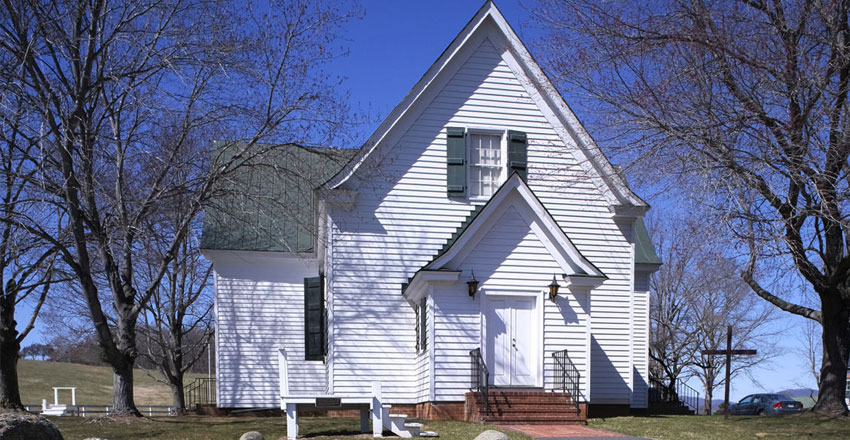
This article appeared on April 10, 2017 in the Fredericksburg Free Lance-Star, written by Peter Kollmann; photo by Bob Brown.
MADISON—Set amid the farmland of rural Madison, Hebron Lutheran Church’s roots go back to the early 1700s, when 20 German families seeking a new life sailed across the Atlantic, headed for Pennsylvania.
But they never got there.
Two theories exist as to why the ship landed in Virginia. One is that a storm pushed the boat south. The other, and more accepted theory, is the captain deliberately took them to Virginia so he could make money by selling the Germans to the state governor.
The 80 Germans began a church group in Germanna, 20 miles north of Fredericksburg, in 1717. After eight miserable years, they moved west to present-day Madison County. There, they built a temporary log church in the Hebron Valley. In 1740, the current church building was erected. It was called the German Chapel or Old Dutch Church until the Hebron name was adopted around 1850.
* * *
Now, 300 years after the congregation formed in 1717, Hebron is still moving forward. On Sunday, April 30, the small church will celebrate its history with an anniversary service at 11 a.m., followed by lunch and several history presentations.
More than 300 people are expected to attend, including Virginia synod officers and the president of Roanoke College, a Lutheran school, according to Bill Price, chairman of Hebron’s 300th anniversary committee. With the church only holding about 200 people, the overflow will be outside under a tent watching on a projector screen.
With local residents making space, coupled with carpooling and buses, parking should be manageable, according to Price. “We’re going to solicit the help of a lot of folks,” he said. “We don’t think parking is going to be an issue.”
Significantly, Hebron possesses a rare 1560 edition of a Martin Luther Bible, written in German. A conservator at the Folger Shakespeare Library in Washington restored the Bible in 2010, and it’s now kept in a vault. The Bible, which is about 9 by 12 by 5 inches, will be on display for the April 30 service.
Hebron’s communion ware is among the oldest of any Lutheran congregation and is still in use.
Those wishing to attend the anniversary service should print the registration form from the church’s website, hebronlutheranva.com, fill it out and return it with payment, which covers all activities and lunch.
* * *
By its status in the Evangelical Lutheran Church of America, Hebron is permitted to have female pastors. Institutions in the Lutheran Church Missouri Synod have only male pastors.
The Rev. Patricia Covington has been the pastor of Hebron Lutheran Church since 2011. The Rev. Karen Taylor was the first woman to lead Hebron, from 2005 to 2009.
“Our sanctuary has been in continuous use as a Lutheran worship site since its construction in 1740,” Taylor stated during her tenure. “We are humbled to minister in the shadow of generations of saints who came before us.”
In his book “History of the Hebron Lutheran Church from 1717-1990,” William Peter Huddle, a former Hebron pastor, stated: “For sixteen years (1717 to 1732), they had been without the services of a Lutheran pastor. They were scattered and like sheep without a shepherd.”
Hebron’s first pastor was John Caspar Stoever, who served a 300-member congregation from 1733 to 1739, until he died at sea sailing back home from Europe.
The Rev. William Carpenter served from 1787 to 1813, the longest tenure of all Hebron’s pastors.
* * *
In January 1789, James Madison and James Monroe—the future fourth and fifth presidents, respectively—attended a service at Hebron Lutheran, then debated outside in the snow for two hours. They talked about the new Constitution and fate of the new federal government. Both men were campaigning to be the first elected member from the 5th Congressional District to the U.S. House of Representatives.
After the debate, Madison rode a horse 12 miles home in the cold. “His nose was frostbitten by the time he got back to Montpelier,” current Hebron member Jane Volchansky said.
Madison won the election on Feb. 2.
In 1790, Carpenter began conducting services in English; they were only done in German before then.
In 1802, a Tannenberg pipe organ was installed after being transported by an ox cart from Pennsylvania. Hebron purchased it for 200 pounds. It was only one of nine remaining Tannenberg organs—and it still exists today, restored in 2015 for excellent service. One of the history presentations on April 30 will be about the organ.
* * *
Hebron suffered a discouraging era from 1820 to 1850. By 1847, the membership had declined to about 70.
The Revs. Alonzo Ludden, with his efficient leadership, and William Bowman, with his pre-eminent pulpit presence, resuscitated Hebron in the 1850s. More than 100 people joined the church. And a new roof and pulpit improved the church’s look.
Some of Hebron’s pastors in the late 1800s also preached at Mount Nebo Lutheran Church, a few miles south in Rochelle.
During Huddle’s tenure, from 1897 to 1921, the membership grew, the Sunday school was prosperous and the current cemetery was established by 1904.
In 1968, when Bernard Troutman was the pastor, a tornado tore apart the Hebron Valley, destroying four 200-year-old oak trees surrounding the church. The church building sustained only minor damage.
Under Troutman, Hebron invested $22,000 to make numerous repairs, including a new altar, communion rail, goblet-shaped pulpit and carpet. The flooring was completely rebuilt to repair damage done by termites. The building also was insulated and painted.
In 1990, Hebron had a 250-year rededication service of the 1740 building. At that time, there were 350 baptized members, a much higher total than the current figure of 100.
On April 30, Hebron members—plus many more—will pass cornfields, cows and the stone wall-surrounded church cemetery on their way to 899 Blankenbaker Road to celebrate 300 years of faith.
